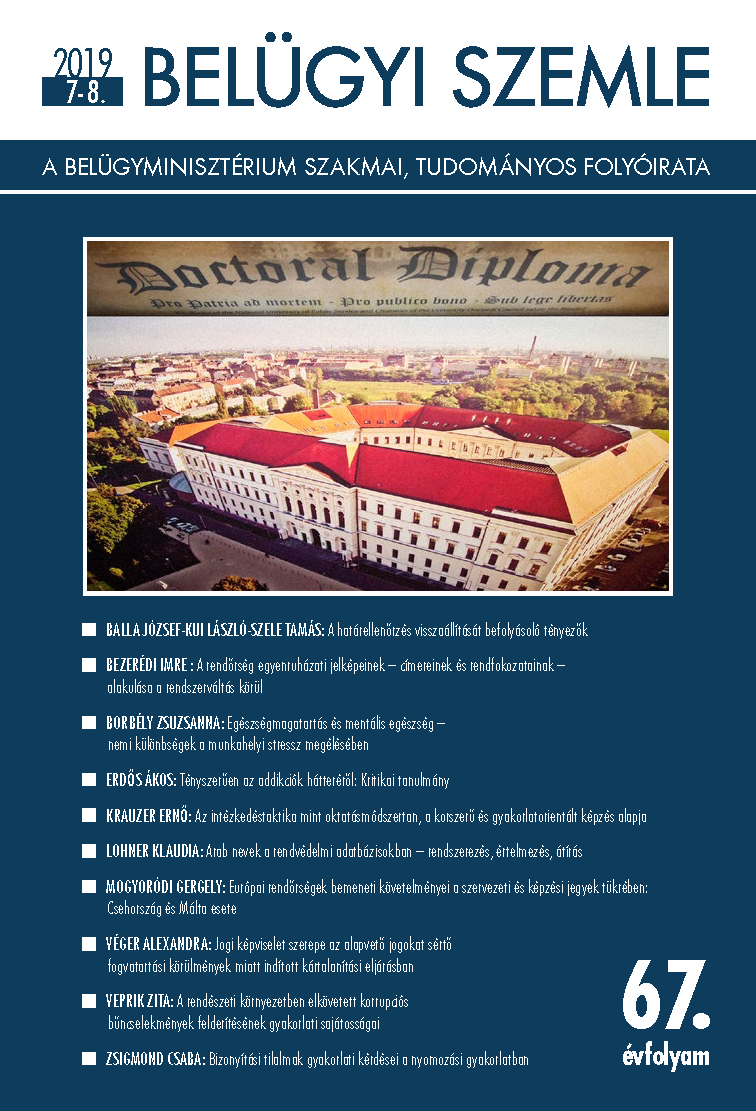Keywords
temporary reintroduction of border control
technical assistance
content of control
security of the Schengen Area
technical assistance
content of control
security of the Schengen Area
How to Cite
Factors Influencing the Reintroduction of Border Control. (2019). Academic Journal of Internal Affairs, 67(7-8), 7-22. https://doi.org/10.38146/BSZ.2019.7-8.1
Abstract
One of the significant acquis of the Schengen idea is that persons, vehicles and consignments are allowed to move freely, without control at the Member States’ internal borders. In case the control mechanism of the Schengen external borders does not grant the security of the area, or a Member State decides to temporarily reintroduce border control at its Schengen internal borders in order to protect its own security, both staff and technology related implications has to be expected. The main purpose of the study is to examine the time, place, content, human resource needs and technical and IT background of the control.
Downloads
Download data is not yet available.
Similar Articles
- Lénárd Zsákai, The system of EU situational pictures showing the current state of the Schengen area , Academic Journal of Internal Affairs: Vol. 73 No. 5 (2025)
- Ferenc Urbán, The global COVID-19 pandemic and the rules of Schengen border control , Academic Journal of Internal Affairs: Vol. 70 No. 3 (2022)
- Mónika Herczeg, Relations between the Member States of the European Union and the Schengen Area , Academic Journal of Internal Affairs: Vol. 70 No. 7 (2022)
- Lénárd Zsákai, Schengen Strategy – Towards a stronger and more resilient Schengen area? , Academic Journal of Internal Affairs: Vol. 70 No. 7 (2022)
- Csaba Borsa, Remarks to a Schengen evaluation , Academic Journal of Internal Affairs: Vol. 68 No. 9 (2020)
- Lénárd Zsákai, International and national coordination of the Schengen evaluation mechanism , Academic Journal of Internal Affairs: Vol. 71 No. 8 (2023)
- Lénárd Zsákai, József Balla, Mónika Herczeg, László Vájlok, Attila Vedó, János Pető, Testing and evaluation of the Automated Border Control System , Academic Journal of Internal Affairs: Vol. 71 No. 2 (2023)
- Ádám Kalmár, Law enforcement cooperation in the framework of the Danube Strategy , Academic Journal of Internal Affairs: Vol. 70 No. 12 (2022)
- Adrienn Magasvári, Péter Olexa, Andrea Szabó, “Who are we really?” Opportunities of revenue and customs authority in development of human resources management , Academic Journal of Internal Affairs: Vol. 69 No. 9 (2021)
- József Balla, László Vájlok, Attila Vedó, 30 years of border police officer training - we don’t need soldiers , Academic Journal of Internal Affairs: Vol. 70 No. 10 (2022)
You may also start an advanced similarity search for this article.
Most read articles by the same author(s)
- Ákos Erdős, József Balla, Non-intrusive Method for Detection of Irregular Migration and Human Smuggling: Practical Experience with the MMD01 Detector in Hungary , Academic Journal of Internal Affairs: Vol. 73 No. 8 (2025)
- József Balla, László Vájlok, Attila Vedó, 30 years of border police officer training - we don’t need soldiers , Academic Journal of Internal Affairs: Vol. 70 No. 10 (2022)
- Lénárd Zsákai, József Balla, Mónika Herczeg, László Vájlok, Attila Vedó, János Pető, Testing and evaluation of the Automated Border Control System , Academic Journal of Internal Affairs: Vol. 71 No. 2 (2023)
- József Balla, László Vájlok, Between East and West. State borders, travel documents, border crossing in Hungary and in Czechoslovakia (1946-1989) , Academic Journal of Internal Affairs: Vol. 68 No. 7 (2020)
- József Balla, The transformation of the methodology of forgery between 1997 and 2017 , Academic Journal of Internal Affairs: Vol. 67 No. 2 (2019)

